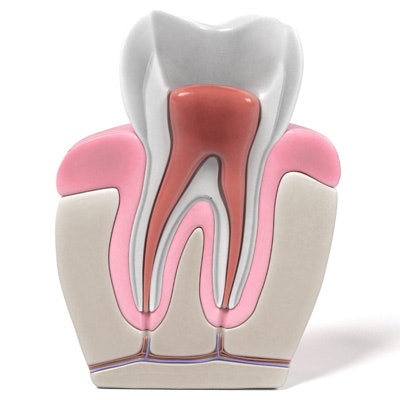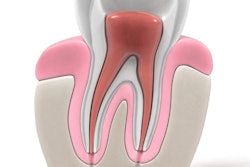
Do newer instruments for preparing root canals induce small dentinal defects that can lead to root fractures, or have improvements in nickel titanium alloys alleviated this potential problem? Since the evidence is unclear, a new study used microcomputed tomography (micro-CT) to analyze dentinal defects in root canals prepared with various instruments.
Researchers examined in vitro mandibular incisors before and after root canal preparation with the ProTaper Next (Dentsply Sirona), K3XF (Kerr Dental), and WaveOne Gold (Dentsply Sirona) and found only pre-existing dentinal damage.
"There was no correlation between the preparation of a root canal using the ProTaper Next, K3XF, and WaveOne Gold systems and the formation of new dentinal defects," they wrote in BMC Oral Health (June 2, 2017).
The authors were led by Marcely Cassimiro from the operative dentistry and endodontics department at the Dental College of Pernambuco in Camaragibe, Brazil.
Getting the all clear
New mechanical devices and techniques have been introduced in recent years that improve root canal preparation, including the WaveOne Gold instrument -- a reciprocating file with a new thermal surface treatment that uses different file diameters and variable tapers. However, concerns have arisen that these instruments, including nickel titanium rotary instruments, can cause small dentinal defects that can lead to root fractures. Studies on the issue have produced varying results.
Additionally, the long-term clinical implications of these dentinal defects remain unknown, as well as whether improvements in nickel titanium alloys have made these defects less likely to form. To learn more about these issues, the researchers of the current study used micro-CT to investigate the presence of dentinal defects after the preparation of a flat-oval root canal system using ProTaper Next, K3XF, and WaveOne Gold instruments.
“No new microcracks were observed after root canal instrumentation with the tested instruments after the analysis.”
They included 82 permanent mandibular incisors with straight root canals (less than 5°) extracted for therapeutic reasons from men and women ages 30 to 50 years without parafunctional habits and with periodontal problems. The teeth were disinfected in a 0.1% thymol solution for 24 hours and then kept in purified filtered water for 30 days. They underwent periapical radiographs in the buccolingual and mesiodistal directions.
The researchers examined the teeth under a stereomicroscope at 15x magnification to detect any pre-existing cracks or fracture lines. The study excluded teeth with inflammatory resorption, calcification, and more than one root canal.
The researchers removed the coronal portions of the teeth so that all samples were 13 mm in length. Then they performed a glide path with a No. 10 K-file (Dentsply Sirona), and they determined the working length of each tooth and that the ratio of buccolingual to mesiodistal coronal third dimensions was similar for each experimental group.
They scanned the incisors using the XT H 225 ST industrial CT system (Nikon) with a low isotropic resolution to identify samples with Vertucci's type 1 anatomical configuration. The 60 selected incisors were rescanned at a high resolution of 14 µm. Researchers performed root canal procedures on 20 teeth with each of the three types of instruments. They also scanned teeth after root canal preparation.
Using two different analysis methods, three endodontists evaluated images taken before and after root canal preparation for dentinal defects. This included a complete evaluation of cross-sectional images and an analysis of each millimeter of 10 apical mm.
The researchers found dentinal defects in nearly half of a total of 45,720 slices, with the rate of defects varying by the type of root canal preparation system used.
However, the researchers found that all the detinal defects identified in the postoperative scans existed in the corresponding preoperative images.
"No new microcracks were observed after root canal instrumentation with the tested instruments after the analysis," the authors wrote.
This was the case with all three root canal preparation systems, even though the WaveOne Gold file has reciprocating movement, and the ProTaper Next and K3XF use rotary movement.
The results are in agreement with other studies but contrary to two studies. One of the contrary studies had a higher curvature angle of the roots, which could explain the formation of dentinal defects, the current study authors noted.
Additionally, they explained that the cross-section of an instrument could affect the number of touches of root dentin and increase dentinal defect formation. However, they found no formation of dentinal defects with all three instruments despite minimal dentin contact with both the ProTaper Next system with a noncentered rectangular cross section with eccentric movement and the WaveOne Gold system with an offset parallelogram-shaped cross section, as well as greater dentin contact with the K3XF instruments with a U-shaped cross section.
Applicability limited
Nevertheless, the authors noted that this work was conducted in vitro and, therefore, the results could not be directly applied to clinical situations. They recommend further research, including studies in situ in jaws of human cadavers with micro-CT analysis of the formation of dentinal defects.
"However, it is possible to conclude that the preparation of a root canal with ProTaper Next, K3XF, and WaveOne Gold instruments does not lead to the formation of dentinal defects," they wrote of their current findings.



















